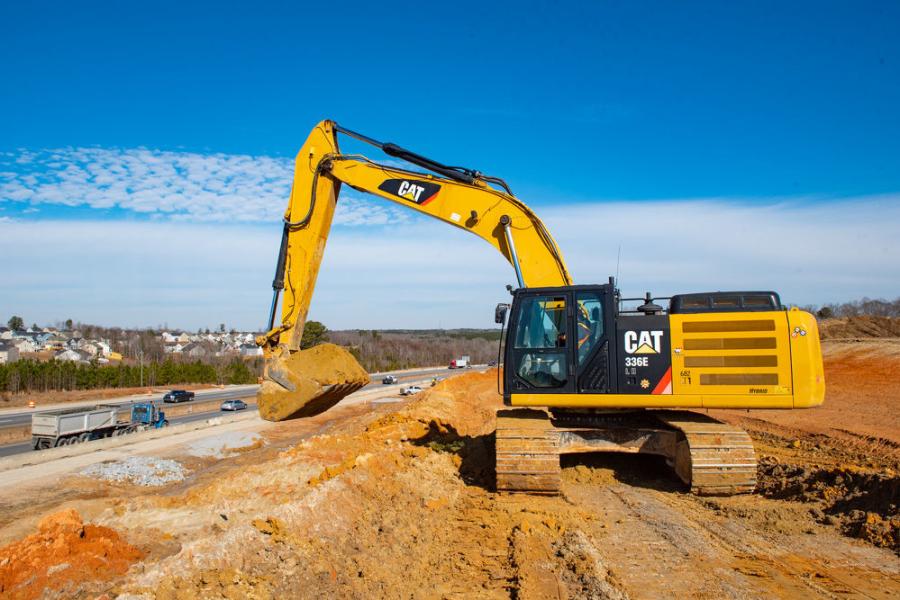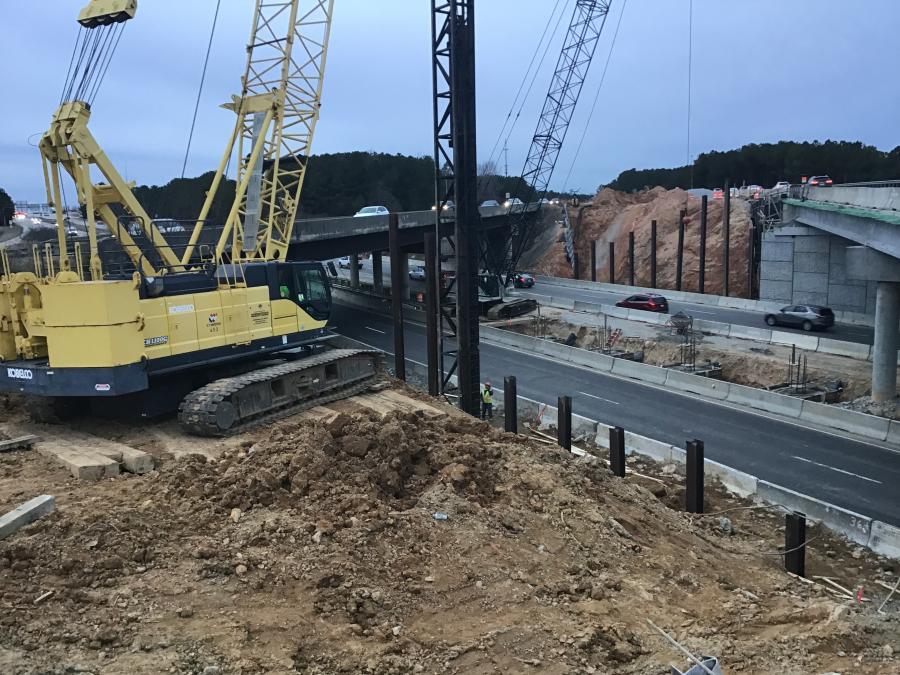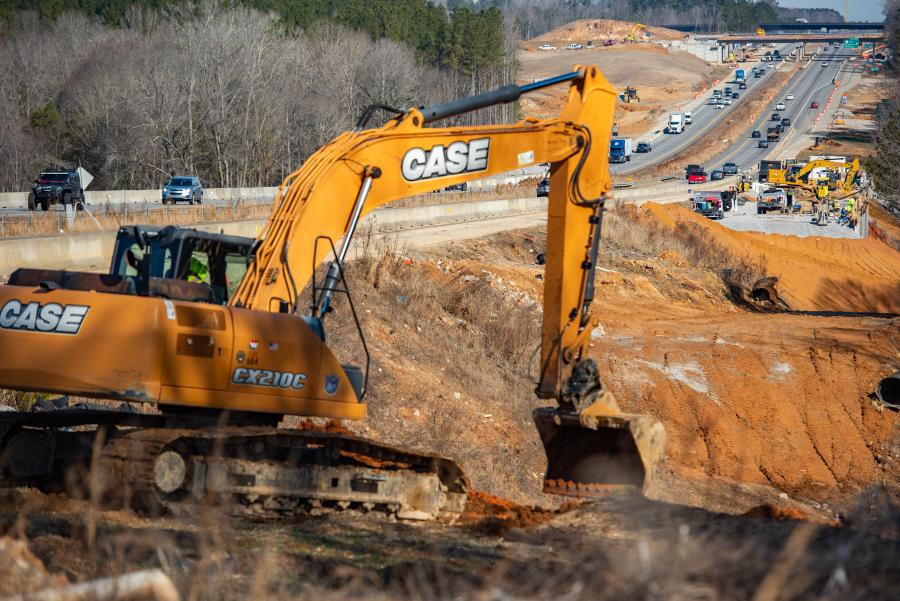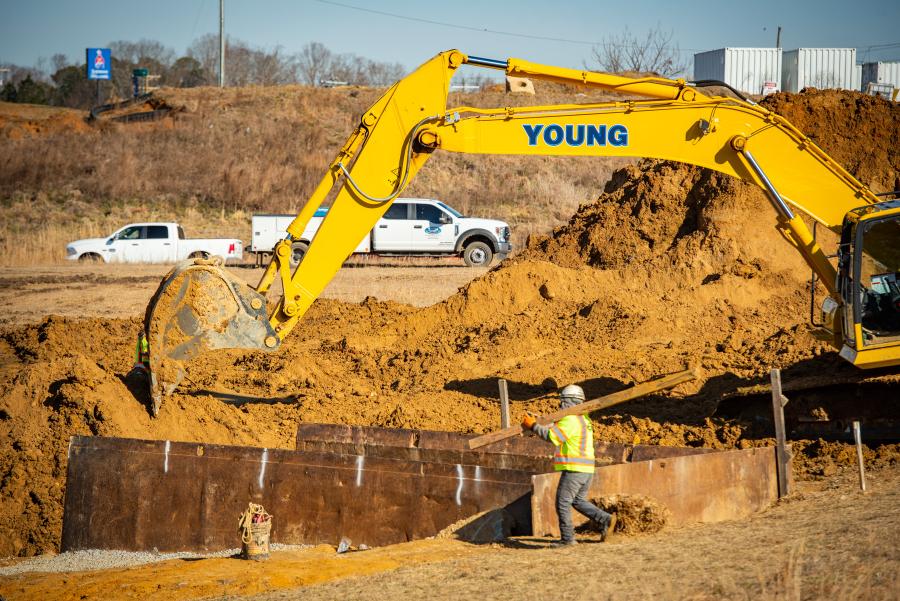A wide variety of heavy machinery is required to complete the work.
(NCDOT photo)
In an effort to improve traffic, construction crews in North Carolina are working on a stretch of I-40 from Raleigh to the I-40/NC 42 interchange in Clayton. The $360 million project was designed to help ease congestion and delays, make travel safer throughout the area and better accommodate motorists due to future growth.
"This 11-mile section of I-40 is designated as a strategic highway corridor by the North Carolina Department of Transportation [NCDOT], and is identified as a regionally significant project in the Capital Area Metropolitan Planning Organization [CAMPO] 2040 Metropolitan Transportation Plan," said NCDOT Division Five engineer Joey Hopkins. "Current traffic conditions on I-40 throughout the entire length of the study corridor are often very crowded and subject to frequent delays due to regional commuting patterns, particularly during morning and evening rush hours.
"With Raleigh and Research Triangle Park serving as employment centers for the region, many people commute into the Raleigh area and live in outlying towns and surrounding counties. This section of I-40 serves suburban communities in Wake and Johnston counties, and also connects to the I-95 corridor. In addition, this leg of I-40 ultimately serves as a primary route to the North Carolina beaches, and during the summer months tends to experience heavy traffic volumes around the weekends."
An estimated 35.6 million vehicles traveled the roadway in 2015, causing congestion and frequent delays, especially in the morning and afternoon rush hours. By the year 2040, traffic is projected to increase 65 percent, with conditions particularly worsening around the I-40/N.C. 42 interchange, due to a significant increase in residential and commercial growth.
"Over the last 10 years, North Carolina has consistently been identified as one of the fastest growing states," said Hopkins. "If we want to continue to be a place that people want to work and live, it's important that our infrastructure keep up with this growth."
S.T. Wooten serves as the general contractor of the project.
"S.T. Wooten is an award-winning North Carolina contractor, with nearly 70 years of experience in heavy highway construction," said Hopkins. "Their experience with similar projects helped to make them an ideal prime contractor for this complicated interstate widening project.
"Crews constructed a temporary ramp from a bridge on East Garner Road to facilitate hauling operations in the median of I-40. This ramp allowed more than 21,000 truckloads of material to be delivered directly to the median, without having to access I-40. By doing this, the contractor was able to continue hauling during times of higher traffic volume, but without the impact to the motoring public."
According to Robert Bullock, NCDOT resident engineer in charge of the project, lane closures are limited to nighttime hours, when traffic is significantly lower to mitigate delays as much as possible.
"The contractor is required to and has maintained the same number of travel lanes throughout construction. The project has created some traffic shifts along I-40. Motorists are coping well with the construction, as no lanes have been reduced. Motorists continue to be encouraged to pay extra attention to the roadway while driving through the work zone, as barrier wall throughout the project protects both the traveling public and workers, but limits the available shoulder area available for vehicles. Distracted driving through the work zone leaves drivers with little room to compensate and make corrective maneuvers."
Lane closures, road closures and hauling operations must be completed during hours of the day with lower traffic volumes, and the best time to do this is during the night or on weekends. Standard day shifts are daylight hours Monday through Friday, with some Saturday work. Night shift is typically 7 p.m. to 5 a.m., Sunday through Friday nights.
"Traffic is the biggest challenge on project," said Bullock. "With the amount of daily traffic passing through the work zone, the project has to be prepared to complete nighttime work promptly, in order to remove traffic control devices each morning to ensure a safe work zone. The amount of traffic volume also limits the scheduling options for the contractor, restricts hauling of materials to and from the project and increases the amount of time to safely complete operations. Traffic shifts throughout the project take significant planning to ensure their success."
Bullock noted that most operations are ongoing, although some in a more limited capacity than others, due to weather.
"Utilities are being moved, water and sewer installation is progressing, outside shoulder grading, ABC and asphalt placement, noise wall construction, drainage installation and erosion control are some of the current operations.
"Four bridge sites are complete. Six bridge sites are under construction. East Garner Road is complete. Several traffic shifts have been completed along I-40. A significant amount of pipe bores are complete, including an 84-in. bore. The U.S. 70 business ramps are in their final patterns on I-40 West."
A total of 12 bridges will be demolished and replaced. The structures will be removed with a combination of saw cutting and hammering of the existing superstructure. Once the superstructure is removed, the girders/beams are typically removed one by one. Each bridge takes between four to eight weeks to demolish under nightly lane closures. The concrete debris is being crushed and recycled for use back into the project. The rebar and metal girders are recycled for scrap off site.
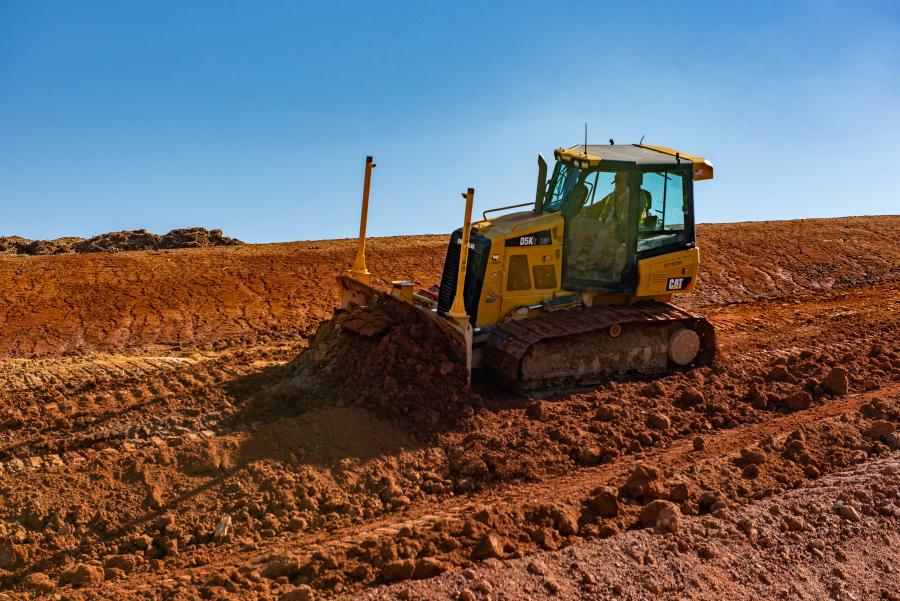
A wide variety of heavy machinery is required to complete the work, including a Komatsu 360LC track excavator with hammer attachment; JLG man-lifts; a Komatsu WA320 rubber tire loader; a skid steer; a Cat D5K2 LGP dozer; Cat 318 rubber tire excavator; Hamm smooth steel drum roller; Cat rubber tire loader; a John Deere 135G mini track excavator; Hamm sheepsfoot roller; a Volvo smooth drum roller; a BOMAG 5500 trench packer; a Cat 330 excavator; a Komatsu WA 250 front-end loader; a Kubota KX040-4 mini-excavator; a Cat 326 trackhoe; and a Case 210EX trackhoe.
Other equipment includes Freightliner flatbed trucks; a Takeuchi TB290 excavator; a Komatsu PC210 LC excavator; a Komatsu PC228US LC excavator; a SANY SY215C LC excavator; a TimberPro TTL745C tree cutter with Quadco cutter attachment; a Cat 320D L excavator; a Vermeer HG6000TX grinder; a Komatsu PC 360 LC track excavator; a Kobelco SK 350 with hoe ram; an American Auger 48/54-900NG boring machine; a Wacker Neuson G25 air compressor; a Miller Trailblazer 275 portable welder; a Freightliner tractor with flatbed trailer; and a John Deere 135G excavator.
Main materials required are concrete, ABC stone, asphalt, soil and steel. The estimated quantity of dirt/material to be moved on the project is 1,450,000 cu. yds.
Bullock said the drainage systems are one of the most time-consuming parts of the project.
"Drainage work has to be completed before many other operations can start, including building embankments, paving, MSE walls and signals. Drainage operations take place in the median, outside shoulders, on y-lines, in environmentally sensitive areas and are greatly affected by rain events.
"There has been a significant bout of wet weather that has slowed progress," said Bullock. "Structure crews continue to work, as long as safety is not impacted."
Construction milestones have included the completion of the East Garner Road bridge, the I-40 flyover bridge and inside I-40 traffic shift from MM 302 to 306. Future milestones include the I-40 outside traffic shift from MM 306 to 308, the NC 42 diverging diamond interchange [DDI] and the Cleveland Road interchange opening.
"The DDI at Jones Sausage Road will require reconstruction of the on and off ramps for I-40 East and West," said Bullock. "The existing bridge has been analyzed and will remain in place. Sidewalk and median barrier wall will be added to the bridge for the traffic shift across the bridge. Additionally, several new traffic signals will be installed to create the DDI traffic pattern.
"There are two new flyover bridges. The work involved building a temporary ramp onto the old flyover bridge to grade to the new flyover bridge from I-440 East. The shorter flyover bridge, Bridge Site 1, is over I-440 East and was constructed during the day, with night time closures for girder erection. The larger flyover bridge, Bridge Site 2, consisted of work over I-440 West, I-40 West and I-40 East. This bridge is a mix of concrete and steel girders. Nighttime closures also were used for girder erection. A temporary shoring tower was constructed adjacent to I-40 East to support the steel girders for that span until the superstructure was completed."
Regarding improvements being made to the I-40/N.C. 42 interchange (exit 312) and surrounding network of roads (including Cleveland Road in Johnston County,) ROW acquisition and utility relocations along NC 42 and Cleveland Road are progressing.
"Once utilities are moved, construction operations will commence," said Bullock. "The major improvements to the NC 42 interchange and Cleveland Road are the installation of the diverging diamond at NC 42 and the new interchange at Cleveland Road. Both improvements should greatly reduce the congestion along NC 42 at I-40, while improving traffic flow to businesses and aiding residents in the area in their daily commute."
Construction is approximately 50 percent complete, with all work expected to be finished by late 2022.
Said Bullock, "The project is extremely rewarding for every member of the team as the group works collectively to provide innovative methods of design and construction that will be viewable upon completion to the entire community and state for the coming decades. CEG
Cindy Riley
Birmingham, Ala., native Cindy RIley originally planned on a career in law, but during her sophomore year in college realized journalism was her true calling. A magna cum laude graduate of Samford University, Riley first worked in radio and TV. Named Best News Anchor, Best News Reporter and Best Investigative Reporter by the Associated Press, she interviewed numerous personalities, ranging from Dr. Henry Kissinger and President Bush to Michael Jordan and Captain Kangaroo.
As a print journalist, Riley has covered a variety of topics, including construction, business, health and the arts. In addition to CEG, her work has appeared in special reports for USA Today and the L.A. Times. Other publications have included New South Magazine, Portico, Thicket, Alabama Heritage, B-Metro, Business First and Birmingham Business Journal.
Read more from Cindy Riley here.
Today's top stories



